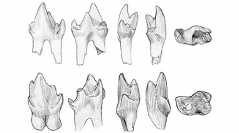

 Geodiversitas
25 (3) - Pages 501-537
Geodiversitas
25 (3) - Pages 501-537From the Kirtlington Bone Bed of England (upper Bathonian), some 700 mammalian specimens, essentially isolated teeth or fragments, have been recovered by British workers; all orders of mammals known for that period are represented. About two thirds of the holotherian molars studied in this paper are attributed to the genus Palaeoxonodon Freeman, 1976, known so far by two lower molars of the type species and a few attributed upper molars. A new species, P. freemani n. sp., also based on lower molars, is proposed. A number of additional upper molars are referred to this genus; they indicate that the latter is not a "peramuran" as previously thought, but an amphitheriid, very close to the genus Blainville, 1838, itself, also known until now by lower dentitions only. Knowledge of amphitheriid upper molars contributes some new light to the discussion of the phylogenetic relationships of this family. In addition, a new taxon of uncertain ordinal position, Kennetheredium leesi n. gen., n. sp., is defined on lower molars. Finally, some teeth could not be precisely identified and are referred to Symmetrodonta indet., Dryolestida indet., Trechnotheria indet. and ?peramurid.
Mammalia, Symmetrodonta, Dryolestida, Amphitheriidae, Peramuridae, upper Bathonian, England, new genus, new species